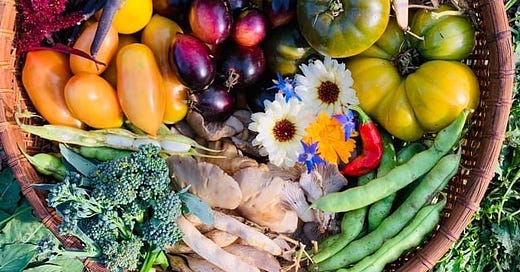Hello friends,
It’s felt like spring this week in Upper Michigan. Plenty of sunshine and above freezing overnight lows have led to significant snow melt and even minor flooding in some areas. The cabin fever is easing as we know gardening season is nearly upon us.
In this newsletter, we’ll discuss the ways in which gardening can increase dietary diversity and why this is important for your health.
What is dietary diversity?
Dietary or food diversity is defined as the number of food items and/or food groups eaten over a given period of time. Data from the NHANES survey demonstrate that most Americans (8 out of 10) do not meet the daily recommendation for fruit and vegetable intake. As a reminder, the USDA guidelines encourage adults to consume 1.5-2 cups of fruit and 2-3 cups of vegetables daily. Researchers have found that home gardeners are more likely to meet these dietary guidelines compared to non-gardeners. Gardening for-the-win! Gardeners like to eat what they grow.
Why is dietary diversity important?
There is a growing body of research to support that increased dietary diversity is associated with reduced incidence of depression, cognitive decline, and type 2 diabetes -just to name a few. The colorful pigments, phytonutrients, found in plants have profound anti-inflammatory effects in the body, which can reduce inflammation and strengthen immune functioning. Most recently, researchers have identified that phytonutrients also support the development of a healthy gut microbiome by increasing microbial diversity.
Tips to increase dietary diversity through gardening
When I think about dietary diversity in the garden, I envision a variety of colorful herbs, vegetables, fruit, legumes, and edible flowers - like those featured in the photo above. This was snapped in my garden or “farmacy” in 2021. I’ve found that September, in my zone 5b garden, is the time of peak abundance (quantity) and diversity (variety).
As we enter another gardening season, consider these tips for increasing your dietary diversity:
Growing Rainbows
I love seeking out colorful varieties of common annual vegetables. Here are a few of our favorites:
The Starburst Carrot blend by High Mowing is a colorful blend that features carrots in striking shades of white, yellow, orange and purple.
The Beauregarde Snow Pea by Row 7 Seed is a stunning purple variety rich in anthocyanins, which promote brain health.
The Sungold cherry tomato by Johnny’s Seed Co. is a classic with farmers markets and home gardeners alike. They are sweet, better than candy, especially when eaten straight from the vine.
Herbs, herbs, herbs
Culinary herbs are a must for the home gardener.
Parsley, sage, rosemary, thyme, basil, and chives are among my favorite varieties (as is Simon & Garfunkel). If you are short on space, these are container friendly.
I also enjoy growing herbs to dry for use in herbal tea blends. These include chamomile, lemon balm, and various mints (tip: keep these in a container unless you want them to spread). More to come on herbal and botanical medicine in future newsletters.
Edible flowers
Marigolds, nasturtium, and borage are easy-to-grow (from seed) edible flowers.
These are also wonderful companion plants and pollinators, which add to the diversity of life in our gardens.
Variety is the spice of life after all. Let’s grow it! Happy gardening!
Yours in health,
Dr. Michelle




